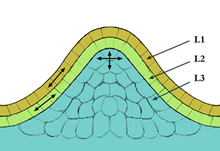Our website is made possible by displaying online advertisements to our visitors.
Please consider supporting us by disabling your ad blocker.
Meristem

In cell biology, the meristem is a structure composed of specialized tissue found in plants, consisting of stem cells, known as meristematic cells, which are undifferentiated cells capable of continuous cell division. These meristematic cells play a fundamental role in plant growth, regeneration, and acclimatization, as they serve as the source of all differentiated plant tissues and organs. They contribute to the formation of structures such as fruits, leaves, and seeds, as well as supportive tissues like stems and roots.[1]
Meristematic cells are totipotent, meaning they retain the ability to differentiate into any plant cell type. As they divide, they generate new cells, some of which remain meristematic while others differentiate into specialized cells that typically lose the ability to divide or produce new cell types. Due to their active division and undifferentiated nature, meristematic cells form the foundation for the formation of new organs and the continuous expansion of the plant body throughout the plant's life cycle.
Meristematic cells are small, with thin primary cell walls and small or no vacuoles. Their protoplasm is dense, filling the entire cell, and they lack intercellular spaces. Instead of mature plastids such as chloroplasts or chromoplasts, these cells contain proplastids, which later develop into fully functional plastids.
Meristematic tissues are classified into three main types based on their location and function: apical meristems, found at the tips of roots and shoots; intercalary or basal meristems, located in the middle regions of stems or leaves, enabling regrowth; and lateral meristems or cambium, responsible for secondary growth in woody plants. At the summit of the meristem, a small group of slowly dividing cells, known as the central zone, acts as a reservoir of stem cells, essential for maintaining meristem activity. The growth and proliferation rates of cells vary within the meristem, with higher activity at the periphery compared to the central region.
The term meristem was first used in 1858 by Swiss botanist Carl Wilhelm von Nägeli (1817–1891) in his book Beiträge zur Wissenschaftlichen Botanik ("Contributions to Scientific Botany").[2] It is derived from Greek μερίζειν (merizein) 'to divide', in recognition of its inherent function.[citation needed]
- ^ a b Lindsay, Penelope; Swentowsky, Kyle W.; Jackson, David (January 2024). "Cultivating potential: Harnessing plant stem cells for agricultural crop improvement". Molecular Plant. 17 (1): 50–74. doi:10.1016/j.molp.2023.12.014. ISSN 1674-2052.
- ^ Galun, Esra (2007). Plant Patterning: Structural and Molecular Genetic Aspects. World Scientific Publishing Company. p. 333. ISBN 9789812704085
Previous Page Next Page


